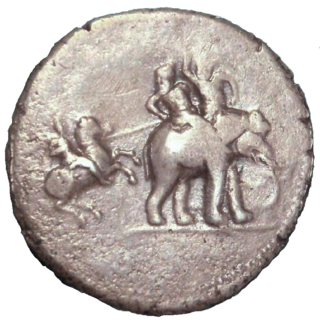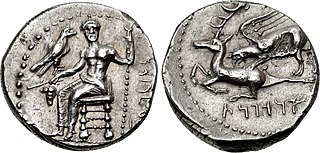
Porus or Poros was an ancient Indian king whose territory spanned the region between the Jhelum River (Hydaspes) and Chenab River (Acesines), in the Punjab region of what is now India and Pakistan. He is only mentioned in Greek sources. Said to be a warrior with exceptional skills, Porus unsuccessfully fought against Alexander the Great in the Battle of the Hydaspes. In the aftermath, an impressed Alexander not only reinstated him as his satrap but also granted him dominion over lands to the south-east extending as far as the Hyphasis (Beas). Porus reportedly died sometime between 321 and 315 BC.

Perdiccas was a Macedonian general, successor of Alexander the Great, and regent of Alexander's empire after his death. When Alexander was dying, he entrusted his signet ring to Perdiccas. Initially the most pre-eminent of the successors, Perdiccas effectively ruled Alexander's increasingly unstable empire from Babylon for three years, until his assassination, as the kings he ruled for were incapable.

Bessus or Bessos, also known by his throne name Artaxerxes V, was a Persian satrap of the eastern Achaemenid satrapy of Bactria, as well as the self-proclaimed King of Kings of the Achaemenid Empire from 330 to 329 BC.

Lysimachus was a Thessalian officer and successor of Alexander the Great, who in 306 BC, became king of Thrace, Asia Minor and Macedon.
Leonnatus was a Macedonian officer of Alexander the Great and one of the diadochi.
Peithon or Pithon was the son of Crateuas, a nobleman from Eordaia in western Macedonia. He was famous for being one of the bodyguards of Alexander the Great, becoming the later satrap of Media, and claiming to be one of the diadochi.

Ariarathes I was the last Achaemenid Persian governor (satrap) of the province (satrapy) of Northern Cappadocia, serving from the 340s BC to 331 BC. He led defensive efforts against the Macedonian invasion, commanded by Alexander the Great, and later fought at the Battle of Gaugamela under Darius III, the last King of Kings of the Achaemenid Empire. After the fall of the Achaemenid Empire, Ariarathes continued his resistance against the Macedonians, ruling concomitantly as an Achaemenid remnant and a precursor to the Kingdom of Cappadocia. He is regarded as the founder of the Iranian Ariarathid dynasty.

Balakros, also Balacrus, the son of Nicanor, one of Alexander the Great's "Somatophylakes" (bodyguards), was appointed satrap of Cilicia after the Battle of Issus, 333 BC. He succeeded to the last Achaemenid satrap of Cilicia, Arsames.
Mithrenes was a Persian commander of the force that garrisoned the citadel of Sardis. According to Cyril Toumanoff, he was also a member of the Orontid dynasty, of Iranian origin. Waldemar Heckel, on the other hand, considers Mithrenes to be a Persian noble of unknown family background. After the battle of the Granicus Mithrenes surrendered voluntarily to Alexander the Great, and was treated by him with great distinction. Mithrenes was present in the Macedonian camp after the Battle of Issus, and Alexander ordered him to visit the captured family of Darius III and assure them that Darius was alive, before changing his mind and assigning the duty to Leonnatus instead. He fought for Alexander at Gaugamela, and ironically he was fighting against an army that included his father Orontes II. Afterwards, Alexander appointed him Satrap of Armenia.
Spitamenes was a Sogdian warlord and the leader of the uprising in Sogdiana and Bactria against Alexander the Great, King of Macedon, in 329 BC. He has been credited by modern historians as one of the most tenacious adversaries of Alexander.
Antigenes served as an officer under Philip II of Macedon and continued his service, rising to the rank of general, under Alexander the Great. He was a commander of the Argyraspides, or Silver Shields.

Drypetis was the daughter of Stateira I and Darius III of Persia. Drypetis was born between 350 and 345 BCE, and, along with her sister Stateira II, was a princess of the Achaemenid dynasty.

Mazaeus or Mazday was an Achaemenid Persian noble, satrap of Cilicia and later satrap of Babylon for the Achaemenid Empire. He retained the satrapy after Babylon was under the rule of Alexander the Great.

Abulites was the Achaemenid satrap (governor) of Susiana during the reign of Darius III, and retained the satrapy as a Hellenistic satrap under Alexander the Great until circa 324 BC, when he was executed for sedition.
Arsames was an Achaemenid Persian satrap of Cilicia in 334/3 BC. He succeeded Mazaeus in this position. He took part in the Battle of Granicus where he fought with his cavalry on the left wing, along with Arsites and Memnon of Rhodes. He was able to survive that battle and flee to the capital of Cilicia Tarsus. There he was planning a scorched-earth policy according to that of Memnon which caused the native Cilician soldiers to abandon their posts. He also decided to burn Tarsus to the ground so as not to fall in the hands of Alexander but was prevented from doing so by the speedy arrival of Parmenion with the light armored units who took the city. After that, Arsames fled to Darius who was at this time in Syria. He was slain at the battle of Issus in 333 BC.

Orontes II was a Persian noble living in the 4th century BC. He is probably to be identified as the satrap of Armenia under Darius III, and may in fact have succeeded Darius in this position when Darius ascended the throne of Persia in 336 BC.
Belesys II was the ruler of Achaemenid Syria as the satrap of Eber-Nari from 358–338 BCE.
Nabarzanes was a high-ranking Persian commander, who served as the chiliarch of the royal cavalry of the Achaemenid King of Kings Darius III.
Barsaentes was a Persian nobleman, who served as the satrap of Arachosia and Drangiana under the Achaemenid King of Kings Darius III.
Oxydates was a Persian nobleman, who served as the satrap of Media under the Macedonian king Alexander the Great from 330 BC to 328 BC. Before his appointment, Oxydates had for an unknown reason been imprisoned at Susa by his former suzerain, the Achaemenid ruler Darius III. He was eventually found and released by Alexander, whom he accompanied to Rhagae. It was during that period Oxydates was appointed satrap of Media, thus replacing Atropates. However, he was convicted of misconduct in late 328 BC, and thus lost his office to Atropates. It unknown what happened to Oxydates afterwards. He may have been arrested or executed by Atropates at the instruction of Alexander, or even managed to escape.











